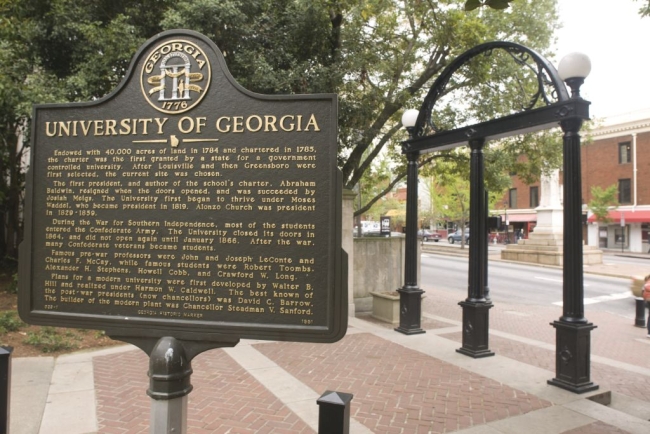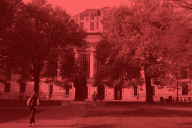You have /5 articles left.
Sign up for a free account or log in.

University of Georgia/Collegiate Images via Getty Images
When some colleges announced this summer that they would be reopening in person, there was backlash. Critics said university administrations were being careless, deluding themselves and setting up the conditions for mass outbreaks.
Now, a little over halfway through the semester, some of those critics’ fears have come to pass, while others have been unfounded. Some colleges have had few to no cases on their campuses. Others have seen unmanageable outbreaks and chosen to close, sending all their students home and continuing education online.
But some institutions have been confronted with outbreaks and high case numbers, and they have chosen to continue on. Those institutions have in many cases been reporting alarming numbers, but they show no signs of shutting down.
Clemson University, a public institution in South Carolina, appears to be among those at the front of the pack. The university has had 3,770 cases as of Oct. 8, according to a tracker from The New York Times. The university enrolls about 25,000 students, meaning that more than 14 percent of the student body has had COVID-19 this semester.
The University of Georgia has similarly been putting up high numbers. Cumulatively, nearly 3,600 students have been infected. If enrollment hasn’t changed from last year, that means about 9 percent of students, including graduate and professional students, have been infected since August.
“In its published guidance, the university describes contingency plans for going fully online,” said Mark Ebell, a professor of epidemiology and biostatistics at UGA, via email. “If leading the country in the number of infected students isn’t enough to activate that contingency plan, then what is?”
At most institutions with high case numbers, including Clemson and UGA, a majority of cases were part of large outbreaks and spikes at the beginning of the semester. Though many students were infected in those first few weeks, numbers have significantly decreased and are now at much more manageable levels. Last week Clemson reported 237 cases, while UGA reported 84. That general pattern is in line with what modeling research has predicted.
Colleges have defended their strategies, pointing to new lows in their curves and further testing.
At Clemson, the university has said that its cumulative case count is high because it is testing more than other universities. Weekly, the university has been reporting 7,000 to 9,000 tests and testing all students who live on campus. While that is significantly more than the many colleges that have no plan or are only testing symptomatic students, some other universities are testing their student bodies more regularly. Tufts University in Boston, for example, is testing all undergraduates twice per week, though it does have a smaller enrollment than Clemson does. Deborah Birx, part of the White House coronavirus task force, has commended Clemson’s testing and transparency.
“We have no way to know precisely what is happening at every university around the nation, but we are certain our testing strategy -- testing asymptomatic as well as symptomatic, trying to aggressively test areas in which we are seeing outsized samples of positive cases, etc. -- is more robust than many universities,” a spokesperson for the university said via email. “So if we have an outsized number of cases identified, it’s likely a result of testing more.”
Last week, Clemson tested more than 7,000 students and had 2.8 percent of tests return positive results. That’s down from a positivity rate of 6.7 percent earlier this month.
John Whitcomb, a professor of nursing and president of the Faculty Senate at Clemson, said he’s been happy with the university’s handling. Faculty have been consulted in decision making, he said.
“I would say the response [from the university] has been overwhelmingly good,” Whitcomb said. “We expected the peak, and the peak occurred.”
“If you do more tests, you’re going to see more cases,” he added.
Rebecca West, editor in chief of the campus newspaper The Tiger News, said that despite the high case counts, feelings of worry and fear haven't overtaken campus. West said she personally knows many people who have gone into isolation or quarantine.
“The first couple people I was shocked, but at this point,” she said, “it's a bit of a routine.”
Some critics of university decisions to reopen have expressed concern around the long-term effects of COVID-19 and spillover into the local community. Even if cases decline, infecting a high share of students, like 15 percent, increases the risk that some may have complications or lasting health effects or may infect those who are more vulnerable.
UGA has also highlighted its recent low figures. Last week only 84 people on campus tested positive for COVID-19. At its peak in early September, the university had reported nearly 1,500 cases in one week.
“The comprehensive preventative measures we have taken on our campus are clearly working, and many students and parents have expressed their appreciation,” said a UGA spokesperson via email.
Ebell, the epidemiology professor, said he has doubts about the accuracy of the university’s reports.
“We’ve had a very large number of reported symptomatic cases, among the highest of any university in the world. These voluntarily reported symptomatic cases have declined, but I think that is in large part because students are choosing to not get tested at the University Health Center and to not report to the university if they are positive,” he said via email.
The university has been testing 1,000 asymptomatic students weekly since late August, and the positivity rates from surveillance testing have ranged from 1.3 percent to 8.9 percent, Ebell said. “If you scale that up to the entire campus population of 38,000 patients, realizing that people will only test positive for a limited time span, it means that a huge number of UGA students have been infected.”
In a document from the White House coronavirus task force, first obtained by Center for Public Integrity, it was estimated that between 15 and 20 percent of students in the state of Georgia have been infected with COVID-19.
Ebell said that the university should be commended for doing surveillance testing, but the fact that it has not been releasing estimates for the whole campus drawn from that surveillance testing is troubling.
“They have not been transparent about what is an open secret on campus, namely that students are choosing to not get tested at [University Health Center] and not report any positives,” he said via email.
In late September, 11 professors from the School of Public Policy and International Affairs released an open letter to the administration asking for measures to limit disease spillover into Athens, Ga.
The Georgia and South Carolina governments have both taken a more lax approach to COVID-19 on college campuses than some other states'. If Clemson and UGA were located in New York, for example, they would already have been forced to go remote for at least two weeks.
A Losing Battle
Justin Simpson, a graduate student at UGA who teaches in the philosophy department and is president of the employee union there, has been part of efforts to try to make the university safer and allow instructors the option to teach remotely. But, he says, there has been growing resignation to the high case numbers.
“In terms of participation [in protests], there seems to be a growing apathy,” he said. “You’re constantly overwhelmed, like an animal that’s been abused.”
“At this point everyone is just so drained from this semester, you’re just out of mental energy,” he added. “The trust has been so eroded about what’s the actual state of health in the Athens area.”
Amelia Wheeler, a graduate student in UGA’s school of education, said that her criticisms of the administration’s response come from a place of love for the university and the Athens community. But she is troubled by the administration’s resistance to making a change and unwillingness to start a dialogue with critical voices. The public K-12 school system in the university area has not been able to open in person due to high metrics of community spread, but the university has been holding football games.
“In the middle of this pandemic while our schools are shut down and schoolchildren are not able to go and learn in person, we are encouraging a mass of strangers to come into our stadium,” she said. “Folks are still really afraid. We’re afraid for our students and for ourselves and for our families and for our community members.”
Though the mood has yet to fall fully into complacency, she said, there is some level of resignation among those who feel powerless to change the university’s decisions.
“There’s a fear, there’s an anger, but there’s also a sense of resignation,” she said. “We can’t do anything because we’re trying to get our Ph.D.s and we need this job.”
As colleges have continued to rack up cases, the outrage and concern that once met them has become quieter.
“Once the students are already on campus, if it’s a residential college, it’s harder to send them home safely,” said Robert Kelchen, a professor of higher education at Seton Hall University. “To some extent the damage has already been done.”
Looking ahead, experts have warned that the winter is likely to bring more infections to the country and to college campuses.
So far, most universities that brought students back this fall are planning to continue that way in the spring.








